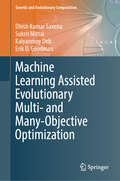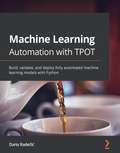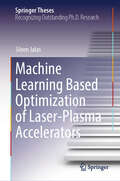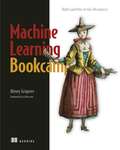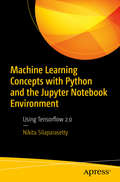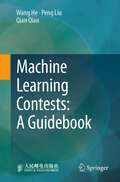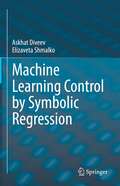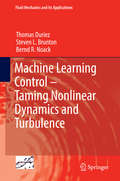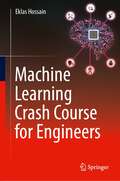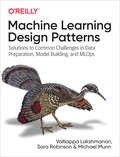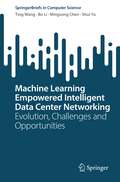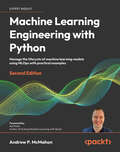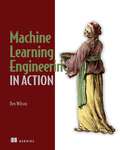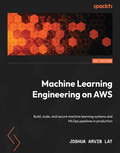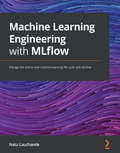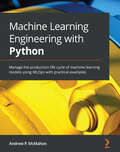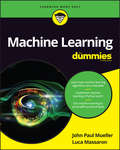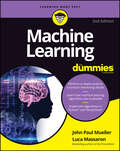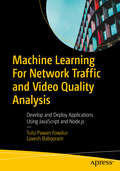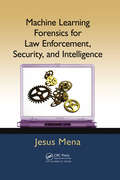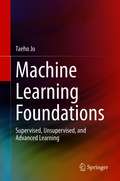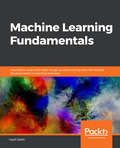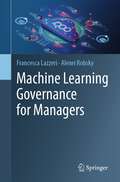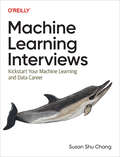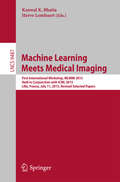- Table View
- List View
Machine Learning Assisted Evolutionary Multi- and Many- Objective Optimization (Genetic and Evolutionary Computation)
by Kalyanmoy Deb Dhish Kumar Saxena Sukrit Mittal Erik D. GoodmanThis book focuses on machine learning (ML) assisted evolutionary multi- and many-objective optimization (EMâO). EMâO algorithms, namely EMâOAs, iteratively evolve a set of solutions towards a good Pareto Front approximation. The availability of multiple solution sets over successive generations makes EMâOAs amenable to application of ML for different pursuits. Recognizing the immense potential for ML-based enhancements in the EMâO domain, this book intends to serve as an exclusive resource for both domain novices and the experienced researchers and practitioners. To achieve this goal, the book first covers the foundations of optimization, including problem and algorithm types. Then, well-structured chapters present some of the key studies on ML-based enhancements in the EMâO domain, systematically addressing important aspects. These include learning to understand the problem structure, converge better, diversify better, simultaneously converge and diversify better, and analyze the Pareto Front. In doing so, this book broadly summarizes the literature, beginning with foundational work on innovization (2003) and objective reduction (2006), and extending to the most recently proposed innovized progress operators (2021-23). It also highlights the utility of ML interventions in the search, post-optimality, and decision-making phases pertaining to the use of EMâOAs. Finally, this book shares insightful perspectives on the future potential for ML based enhancements in the EMâOA domain.To aid readers, the book includes working codes for the developed algorithms. This book will not only strengthen this emergent theme but also encourage ML researchers to develop more efficient and scalable methods that cater to the requirements of the EMâOA domain. It serves as an inspiration for further research and applications at the synergistic intersection of EMâOA and ML domains.
Machine Learning Automation with TPOT: Build, validate, and deploy fully automated machine learning models with Python
by Dario RadecicDiscover how TPOT can be used to handle automation in machine learning and explore the different types of tasks that TPOT can automateKey FeaturesUnderstand parallelism and how to achieve it in Python.Learn how to use neurons, layers, and activation functions and structure an artificial neural network.Tune TPOT models to ensure optimum performance on previously unseen data.Book DescriptionThe automation of machine learning tasks allows developers more time to focus on the usability and reactivity of the software powered by machine learning models. TPOT is a Python automated machine learning tool used for optimizing machine learning pipelines using genetic programming. Automating machine learning with TPOT enables individuals and companies to develop production-ready machine learning models cheaper and faster than with traditional methods. With this practical guide to AutoML, developers working with Python on machine learning tasks will be able to put their knowledge to work and become productive quickly. You'll adopt a hands-on approach to learning the implementation of AutoML and associated methodologies. Complete with step-by-step explanations of essential concepts, practical examples, and self-assessment questions, this book will show you how to build automated classification and regression models and compare their performance to custom-built models. As you advance, you'll also develop state-of-the-art models using only a couple of lines of code and see how those models outperform all of your previous models on the same datasets. By the end of this book, you'll have gained the confidence to implement AutoML techniques in your organization on a production level. What you will learnGet to grips with building automated machine learning modelsBuild classification and regression models with impressive accuracy in a short timeDevelop neural network classifiers with AutoML techniquesCompare AutoML models with traditional, manually developed models on the same datasetsCreate robust, production-ready modelsEvaluate automated classification models based on metrics such as accuracy, recall, precision, and f1-scoreGet hands-on with deployment using Flask-RESTful on localhostWho this book is forData scientists, data analysts, and software developers who are new to machine learning and want to use it in their applications will find this book useful. This book is also for business users looking to automate business tasks with machine learning. Working knowledge of the Python programming language and beginner-level understanding of machine learning are necessary to get started.
Machine Learning Based Optimization of Laser-Plasma Accelerators (Springer Theses)
by Sören JalasThis book explores the application of machine learning-based methods, particularly Bayesian optimization, within the realm of laser-plasma accelerators. The book involves the implementation of Bayesian optimization to fine tune the parameters of the lux accelerator, encompassing simulations and real-time experimentation. In combination, the methods presented in this book provide valuable tools for effectively managing the inherent complexity of LPAs, spanning from the design phase in simulations to real-time operation, potentially paving the way for LPAs to cater to a wide array of applications with diverse demands.
Machine Learning Bookcamp: Build a portfolio of real-life projects
by Alexey GrigorevTime to flex your machine learning muscles! Take on the carefully designed challenges of the Machine Learning Bookcamp and master essential ML techniques through practical application.Summary In Machine Learning Bookcamp you will: Collect and clean data for training models Use popular Python tools, including NumPy, Scikit-Learn, and TensorFlow Apply ML to complex datasets with images Deploy ML models to a production-ready environment The only way to learn is to practice! In Machine Learning Bookcamp, you&’ll create and deploy Python-based machine learning models for a variety of increasingly challenging projects. Taking you from the basics of machine learning to complex applications such as image analysis, each new project builds on what you&’ve learned in previous chapters. You&’ll build a portfolio of business-relevant machine learning projects that hiring managers will be excited to see. Purchase of the print book includes a free eBook in PDF, Kindle, and ePub formats from Manning Publications. About the technology Master key machine learning concepts as you build actual projects! Machine learning is what you need for analyzing customer behavior, predicting price trends, evaluating risk, and much more. To master ML, you need great examples, clear explanations, and lots of practice. This book delivers all three! About the book Machine Learning Bookcamp presents realistic, practical machine learning scenarios, along with crystal-clear coverage of key concepts. In it, you&’ll complete engaging projects, such as creating a car price predictor using linear regression and deploying a churn prediction service. You&’ll go beyond the algorithms and explore important techniques like deploying ML applications on serverless systems and serving models with Kubernetes and Kubeflow. Dig in, get your hands dirty, and have fun building your ML skills! What's inside Collect and clean data for training models Use popular Python tools, including NumPy, Scikit-Learn, and TensorFlow Deploy ML models to a production-ready environment About the reader Python programming skills assumed. No previous machine learning knowledge is required. About the author Alexey Grigorev is a principal data scientist at OLX Group. He runs DataTalks.Club, a community of people who love data. Table of Contents 1 Introduction to machine learning 2 Machine learning for regression 3 Machine learning for classification 4 Evaluation metrics for classification 5 Deploying machine learning models 6 Decision trees and ensemble learning 7 Neural networks and deep learning 8 Serverless deep learning 9 Serving models with Kubernetes and Kubeflow
Machine Learning Concepts with Python and the Jupyter Notebook Environment: Using Tensorflow 2.0
by Nikita SilaparasettyCreate, execute, modify, and share machine learning applications with Python and TensorFlow 2.0 in the Jupyter Notebook environment. This book breaks down any barriers to programming machine learning applications through the use of Jupyter Notebook instead of a text editor or a regular IDE.You’ll start by learning how to use Jupyter Notebooks to improve the way you program with Python. After getting a good grounding in working with Python in Jupyter Notebooks, you’ll dive into what TensorFlow is, how it helps machine learning enthusiasts, and how to tackle the challenges it presents. Along the way, sample programs created using Jupyter Notebooks allow you to apply concepts from earlier in the book.Those who are new to machine learning can dive in with these easy programs and develop basic skills. A glossary at the end of the book provides common machine learning and Python keywords and definitions to make learning even easier. What You Will LearnProgram in Python and TensorFlowTackle basic machine learning obstaclesDevelop in the Jupyter Notebooks environmentWho This Book Is ForIdeal for Machine Learning and Deep Learning enthusiasts who are interested in programming with Python using Tensorflow 2.0 in the Jupyter Notebook Application. Some basic knowledge of Machine Learning concepts and Python Programming (using Python version 3) is helpful.
Machine Learning Contests: A Guidebook
by Peng Liu Qian Qian Wang HeThis book systematically introduces the competitions in the field of algorithm and machine learning. The first author of the book has won 5 championships and 5 runner-ups in domestic and international algorithm competitions.Firstly, it takes common competition scenarios as a guide by giving the main processes of using machine learning to solve real-world problems, namely problem modelling, data exploration, feature engineering, model training. And then lists the main points of difficulties, general ideas with solutions in the whole process. Moreover, this book comprehensively covers several common problems in the field of machine learning competitions such as recommendation, temporal prediction, advertising, text computing, etc. The authors, also knew as "competition professionals”, will explain the actual cases in detail and teach you various processes, routines, techniques and strategies, which is a rare treasure book for all competition enthusiasts. It is very suitable for readers who are interested in algorithm competitions and deep learning algorithms in practice, or computer-related majors.
Machine Learning Control by Symbolic Regression
by Askhat Diveev Elizaveta ShmalkoThis book provides comprehensive coverage on a new direction in computational mathematics research: automatic search for formulas. Formulas must be sought in all areas of science and life: these are the laws of the universe, the macro and micro world, fundamental physics, engineering, weather and natural disasters forecasting; the search for new laws in economics, politics, sociology. Accumulating many years of experience in the development and application of numerical methods of symbolic regression to solving control problems, the authors offer new possibilities not only in the field of control automation, but also in the design of completely different optimal structures in many fields. For specialists in the field of control, Machine Learning Control by Symbolic Regression opens up a new promising direction of research and acquaints scientists with the methods of automatic construction of control systems.For specialists in the field of machine learning, the book opens up a new, much broader direction than neural networks: methods of symbolic regression. This book makes it easy to master this new area in machine learning and apply this approach everywhere neural networks are used. For mathematicians, the book opens up a new approach to the construction of numerical methods for obtaining analytical solutions to unsolvable problems; for example, numerical analytical solutions of algebraic equations, differential equations, non-trivial integrals, etc. For specialists in the field of artificial intelligence, the book offers a machine way to solve problems, framed in the form of analytical relationships.
Machine Learning Control – Taming Nonlinear Dynamics and Turbulence
by Thomas Duriez Steven L. Brunton Bernd R. NoackThis is the first textbook on a generally applicable control strategy for turbulence and other complex nonlinear systems. The approach of the book employs powerful methods of machine learning for optimal nonlinear control laws. This machine learning control (MLC) is motivated and detailed in Chapters 1 and 2. In Chapter 3, methods of linear control theory are reviewed. In Chapter 4, MLC is shown to reproduce known optimal control laws for linear dynamics (LQR, LQG). In Chapter 5, MLC detects and exploits a strongly nonlinear actuation mechanism of a low-dimensional dynamical system when linear control methods are shown to fail. Experimental control demonstrations from a laminar shear-layer to turbulent boundary-layers are reviewed in Chapter 6, followed by general good practices for experiments in Chapter 7. The book concludes with an outlook on the vast future applications of MLC in Chapter 8. Matlab codes are provided for easy reproducibility of the presented results. The book includes interviews with leading researchers in turbulence control (S. Bagheri, B. Batten, M. Glauser, D. Williams) and machine learning (M. Schoenauer) for a broader perspective. All chapters have exercises and supplemental videos will be available through YouTube.
Machine Learning Crash Course for Engineers
by Eklas HossainMachine Learning Crash Course for Engineers is a reader-friendly introductory guide to machine learning algorithms and techniques for students, engineers, and other busy technical professionals. The book focuses on the application aspects of machine learning, progressing from the basics to advanced topics systematically from theory to applications and worked-out Python programming examples. It offers highly illustrated, step-by-step demonstrations that allow readers to implement machine learning models to solve real-world problems. This powerful tutorial is an excellent resource for those who need to acquire a solid foundational understanding of machine learning quickly.
Machine Learning Design Patterns
by Michael Munn Valliappa Lakshmanan Sara RobinsonThe design patterns in this book capture best practices and solutions to recurring problems in machine learning. The authors, three Google engineers, catalog proven methods to help data scientists tackle common problems throughout the ML process. These design patterns codify the experience of hundreds of experts into straightforward, approachable advice.In this book, you will find detailed explanations of 30 patterns for data and problem representation, operationalization, repeatability, reproducibility, flexibility, explainability, and fairness. Each pattern includes a description of the problem, a variety of potential solutions, and recommendations for choosing the best technique for your situation.You'll learn how to:Identify and mitigate common challenges when training, evaluating, and deploying ML modelsRepresent data for different ML model types, including embeddings, feature crosses, and moreChoose the right model type for specific problemsBuild a robust training loop that uses checkpoints, distribution strategy, and hyperparameter tuningDeploy scalable ML systems that you can retrain and update to reflect new dataInterpret model predictions for stakeholders and ensure models are treating users fairly
Machine Learning Empowered Intelligent Data Center Networking: Evolution, Challenges and Opportunities (SpringerBriefs in Computer Science)
by Mingsong Chen Ting Wang Shui Yu Bo LiAn Introduction to the Machine Learning Empowered Intelligent Data Center Networking Fundamentals of Machine Learning in Data Center Networks. This book reviews the common learning paradigms that are widely used in data centernetworks, and offers an introduction to data collection and data processing in data centers. Additionally, it proposes a multi-dimensional and multi-perspective solution quality assessment system called REBEL-3S. The book offers readers a solid foundation for conducting research in the field of AI-assisted data center networks. Comprehensive Survey of AI-assisted Intelligent Data Center Networks. This book comprehensively investigates the peer-reviewed literature published in recent years. The wide range of machine learning techniques is fully reflected to allow fair comparisons. In addition, the book provides in-depth analysis and enlightening discussions on the effectiveness of AI in DCNs from various perspectives, covering flow prediction, flow classification, load balancing, resource management, energy management, routing optimization, congestion control, fault management, and network security.Provides a Broad Overview with Key Insights. This book introduces several novel intelligent networking concepts pioneered by real-world industries, such as Knowledge Defined Networks, Self-Driving Networks, Intent-driven Networks and Intent-based Networks. Moreover, it shares unique insights into the technological evolution of the fusion of artificial intelligence and data center networks, together with selected challenges and future research opportunities.
Machine Learning Engineering with Python: Manage the lifecycle of machine learning models using MLOps with practical examples
by Andrew P. McMahonTransform your machine learning projects into successful deployments with this practical guide on how to build and scale solutions that solve real-world problems Includes a new chapter on generative AI and large language models (LLMs) and building a pipeline that leverages LLMs using LangChainKey FeaturesThis second edition delves deeper into key machine learning topics, CI/CD, and system designExplore core MLOps practices, such as model management and performance monitoringBuild end-to-end examples of deployable ML microservices and pipelines using AWS and open-source toolsBook DescriptionThe Second Edition of Machine Learning Engineering with Python is the practical guide that MLOps and ML engineers need to build solutions to real-world problems. It will provide you with the skills you need to stay ahead in this rapidly evolving field. The book takes an examples-based approach to help you develop your skills and covers the technical concepts, implementation patterns, and development methodologies you need. You'll explore the key steps of the ML development lifecycle and create your own standardized "model factory" for training and retraining of models. You'll learn to employ concepts like CI/CD and how to detect different types of drift. Get hands-on with the latest in deployment architectures and discover methods for scaling up your solutions. This edition goes deeper in all aspects of ML engineering and MLOps, with emphasis on the latest open-source and cloud-based technologies. This includes a completely revamped approach to advanced pipelining and orchestration techniques. With a new chapter on deep learning, generative AI, and LLMOps, you will learn to use tools like LangChain, PyTorch, and Hugging Face to leverage LLMs for supercharged analysis. You will explore AI assistants like GitHub Copilot to become more productive, then dive deep into the engineering considerations of working with deep learning.What you will learnPlan and manage end-to-end ML development projectsExplore deep learning, LLMs, and LLMOps to leverage generative AIUse Python to package your ML tools and scale up your solutionsGet to grips with Apache Spark, Kubernetes, and RayBuild and run ML pipelines with Apache Airflow, ZenML, and KubeflowDetect drift and build retraining mechanisms into your solutionsImprove error handling with control flows and vulnerability scanningHost and build ML microservices and batch processes running on AWSWho this book is forThis book is designed for MLOps and ML engineers, data scientists, and software developers who want to build robust solutions that use machine learning to solve real-world problems. If you’re not a developer but want to manage or understand the product lifecycle of these systems, you’ll also find this book useful. It assumes a basic knowledge of machine learning concepts and intermediate programming experience in Python. With its focus on practical skills and real-world examples, this book is an essential resource for anyone looking to advance their machine learning engineering career.
Machine Learning Engineering in Action
by Ben WilsonField-tested tips, tricks, and design patterns for building machine learning projects that are deployable, maintainable, and secure from concept to production.In Machine Learning Engineering in Action, you will learn: Evaluating data science problems to find the most effective solution Scoping a machine learning project for usage expectations and budget Process techniques that minimize wasted effort and speed up production Assessing a project using standardized prototyping work and statistical validation Choosing the right technologies and tools for your project Making your codebase more understandable, maintainable, and testable Automating your troubleshooting and logging practices Ferrying a machine learning project from your data science team to your end users is no easy task. Machine Learning Engineering in Action will help you make it simple. Inside, you'll find fantastic advice from veteran industry expert Ben Wilson, Principal Resident Solutions Architect at Databricks. Ben introduces his personal toolbox of techniques for building deployable and maintainable production machine learning systems. You'll learn the importance of Agile methodologies for fast prototyping and conferring with stakeholders, while developing a new appreciation for the importance of planning. Adopting well-established software development standards will help you deliver better code management, and make it easier to test, scale, and even reuse your machine learning code. Every method is explained in a friendly, peer-to-peer style and illustrated with production-ready source code. About the technology Deliver maximum performance from your models and data. This collection of reproducible techniques will help you build stable data pipelines, efficient application workflows, and maintainable models every time. Based on decades of good software engineering practice, machine learning engineering ensures your ML systems are resilient, adaptable, and perform in production. About the book Machine Learning Engineering in Action teaches you core principles and practices for designing, building, and delivering successful machine learning projects. You'll discover software engineering techniques like conducting experiments on your prototypes and implementing modular design that result in resilient architectures and consistent cross-team communication. Based on the author's extensive experience, every method in this book has been used to solve real-world projects. What's inside Scoping a machine learning project for usage expectations and budget Choosing the right technologies for your design Making your codebase more understandable, maintainable, and testable Automating your troubleshooting and logging practices About the reader For data scientists who know machine learning and the basics of object-oriented programming. About the author Ben Wilson is Principal Resident Solutions Architect at Databricks, where he developed the Databricks Labs AutoML project, and is an MLflow committer.
Machine Learning Engineering on AWS: Build, scale, and secure machine learning systems and MLOps pipelines in production
by Joshua Arvin LatWork seamlessly with production-ready machine learning systems and pipelines on AWS by addressing key pain points encountered in the ML life cycleKey FeaturesGain practical knowledge of managing ML workloads on AWS using Amazon SageMaker, Amazon EKS, and moreUse container and serverless services to solve a variety of ML engineering requirementsDesign, build, and secure automated MLOps pipelines and workflows on AWSBook DescriptionThere is a growing need for professionals with experience in working on machine learning (ML) engineering requirements as well as those with knowledge of automating complex MLOps pipelines in the cloud. This book explores a variety of AWS services, such as Amazon Elastic Kubernetes Service, AWS Glue, AWS Lambda, Amazon Redshift, and AWS Lake Formation, which ML practitioners can leverage to meet various data engineering and ML engineering requirements in production.This machine learning book covers the essential concepts as well as step-by-step instructions that are designed to help you get a solid understanding of how to manage and secure ML workloads in the cloud. As you progress through the chapters, you'll discover how to use several container and serverless solutions when training and deploying TensorFlow and PyTorch deep learning models on AWS. You'll also delve into proven cost optimization techniques as well as data privacy and model privacy preservation strategies in detail as you explore best practices when using each AWS.By the end of this AWS book, you'll be able to build, scale, and secure your own ML systems and pipelines, which will give you the experience and confidence needed to architect custom solutions using a variety of AWS services for ML engineering requirements.What you will learnFind out how to train and deploy TensorFlow and PyTorch models on AWSUse containers and serverless services for ML engineering requirementsDiscover how to set up a serverless data warehouse and data lake on AWSBuild automated end-to-end MLOps pipelines using a variety of servicesUse AWS Glue DataBrew and SageMaker Data Wrangler for data engineeringExplore different solutions for deploying deep learning models on AWSApply cost optimization techniques to ML environments and systemsPreserve data privacy and model privacy using a variety of techniquesWho this book is forThis book is for machine learning engineers, data scientists, and AWS cloud engineers interested in working on production data engineering, machine learning engineering, and MLOps requirements using a variety of AWS services such as Amazon EC2, Amazon Elastic Kubernetes Service (EKS), Amazon SageMaker, AWS Glue, Amazon Redshift, AWS Lake Formation, and AWS Lambda -- all you need is an AWS account to get started. Prior knowledge of AWS, machine learning, and the Python programming language will help you to grasp the concepts covered in this book more effectively.
Machine Learning Engineering with MLflow: Manage the end-to-end machine learning life cycle with MLflow
by Natu LauchandeGet up and running, and productive in no time with MLflow using the most effective machine learning engineering approachKey FeaturesExplore machine learning workflows for stating ML problems in a concise and clear manner using MLflowUse MLflow to iteratively develop a ML model and manage it Discover and work with the features available in MLflow to seamlessly take a model from the development phase to a production environmentBook DescriptionMLflow is a platform for the machine learning life cycle that enables structured development and iteration of machine learning models and a seamless transition into scalable production environments.This book will take you through the different features of MLflow and how you can implement them in your ML project. You will begin by framing an ML problem and then transform your solution with MLflow, adding a workbench environment, training infrastructure, data management, model management, experimentation, and state-of-the-art ML deployment techniques on the cloud and premises. The book also explores techniques to scale up your workflow as well as performance monitoring techniques. As you progress, you'll discover how to create an operational dashboard to manage machine learning systems. Later, you will learn how you can use MLflow in the AutoML, anomaly detection, and deep learning context with the help of use cases. In addition to this, you will understand how to use machine learning platforms for local development as well as for cloud and managed environments. This book will also show you how to use MLflow in non-Python-based languages such as R and Java, along with covering approaches to extend MLflow with Plugins.By the end of this machine learning book, you will be able to produce and deploy reliable machine learning algorithms using MLflow in multiple environments.What you will learnDevelop your machine learning project locally with MLflow's different featuresSet up a centralized MLflow tracking server to manage multiple MLflow experimentsCreate a model life cycle with MLflow by creating custom modelsUse feature streams to log model results with MLflowDevelop the complete training pipeline infrastructure using MLflow featuresSet up an inference-based API pipeline and batch pipeline in MLflowScale large volumes of data by integrating MLflow with high-performance big data librariesWho this book is forThis book is for data scientists, machine learning engineers, and data engineers who want to gain hands-on machine learning engineering experience and learn how they can manage an end-to-end machine learning life cycle with the help of MLflow. Intermediate-level knowledge of the Python programming language is expected.
Machine Learning Engineering with Python: Manage the production life cycle of machine learning models using MLOps with practical examples
by Andrew P. McMahonSupercharge the value of your machine learning models by building scalable and robust solutions that can serve them in production environmentsKey FeaturesExplore hyperparameter optimization and model management toolsLearn object-oriented programming and functional programming in Python to build your own ML libraries and packagesExplore key ML engineering patterns like microservices and the Extract Transform Machine Learn (ETML) pattern with use casesBook DescriptionMachine learning engineering is a thriving discipline at the interface of software development and machine learning. This book will help developers working with machine learning and Python to put their knowledge to work and create high-quality machine learning products and services. Machine Learning Engineering with Python takes a hands-on approach to help you get to grips with essential technical concepts, implementation patterns, and development methodologies to have you up and running in no time. You'll begin by understanding key steps of the machine learning development life cycle before moving on to practical illustrations and getting to grips with building and deploying robust machine learning solutions. As you advance, you'll explore how to create your own toolsets for training and deployment across all your projects in a consistent way. The book will also help you get hands-on with deployment architectures and discover methods for scaling up your solutions while building a solid understanding of how to use cloud-based tools effectively. Finally, you'll work through examples to help you solve typical business problems. By the end of this book, you'll be able to build end-to-end machine learning services using a variety of techniques and design your own processes for consistently performant machine learning engineering.What you will learnFind out what an effective ML engineering process looks likeUncover options for automating training and deployment and learn how to use themDiscover how to build your own wrapper libraries for encapsulating your data science and machine learning logic and solutionsUnderstand what aspects of software engineering you can bring to machine learningGain insights into adapting software engineering for machine learning using appropriate cloud technologiesPerform hyperparameter tuning in a relatively automated wayWho this book is forThis book is for machine learning engineers, data scientists, and software developers who want to build robust software solutions with machine learning components. If you're someone who manages or wants to understand the production life cycle of these systems, you'll find this book useful. Intermediate-level knowledge of Python is necessary.
Machine Learning For Dummies
by John Paul Mueller Luca MassaronYour no-nonsense guide to making sense of machine learning Machine learning can be a mind-boggling concept for the masses, but those who are in the trenches of computer programming know just how invaluable it is. Without machine learning, fraud detection, web search results, real-time ads on web pages, credit scoring, automation, and email spam filtering wouldn't be possible, and this is only showcasing just a few of its capabilities. Written by two data science experts, Machine Learning For Dummies offers a much-needed entry point for anyone looking to use machine learning to accomplish practical tasks. Covering the entry-level topics needed to get you familiar with the basic concepts of machine learning, this guide quickly helps you make sense of the programming languages and tools you need to turn machine learning-based tasks into a reality. Whether you're maddened by the math behind machine learning, apprehensive about AI, perplexed by preprocessing data--or anything in between--this guide makes it easier to understand and implement machine learning seamlessly. Grasp how day-to-day activities are powered by machine learning Learn to 'speak' certain languages, such as Python and R, to teach machines to perform pattern-oriented tasks and data analysis Learn to code in R using R Studio Find out how to code in Python using Anaconda Dive into this complete beginner's guide so you are armed with all you need to know about machine learning!
Machine Learning For Dummies
by John Paul Mueller Luca MassaronYour comprehensive entry-level guide to machine learning While machine learning expertise doesn’t quite mean you can create your own Turing Test-proof android—as in the movie Ex Machina—it is a form of artificial intelligence and one of the most exciting technological means of identifying opportunities and solving problems fast and on a large scale. Anyone who masters the principles of machine learning is mastering a big part of our tech future and opening up incredible new directions in careers that include fraud detection, optimizing search results, serving real-time ads, credit- scoring, building accurate and sophisticated pricing models—and way, way more. Unlike most machine learning books, the fully updated 2nd Edition of Machine Learning For Dummies doesn’t assume you have years of experience using programming languages such as Python (R source is also included in a downloadable form with comments and explanations), but lets you in on the ground floor, covering the entry-level materials that will get you up and running building models you need to perform practical tasks. It takes a look at the underlying—and fascinating—math principles that power machine learning but also shows that you don’t need to be a math whiz to build fun new tools and apply them to your work and study. Understand the history of AI and machine learning Work with Python 3.8 and TensorFlow 2.x (and R as a download) Build and test your own models Use the latest datasets, rather than the worn out data found in other books Apply machine learning to real problems Whether you want to learn for college or to enhance your business or career performance, this friendly beginner’s guide is your best introduction to machine learning, allowing you to become quickly confident using this amazing and fast-developing technology that’s impacting lives for the better all over the world.
Machine Learning For Network Traffic and Video Quality Analysis: Develop and Deploy Applications Using JavaScript and Node.js
by Tulsi Pawan Fowdur Lavesh BabooramThis book offers both theoretical insights and hands-on experience in understanding and building machine learning-based Network Traffic Monitoring and Analysis (NTMA) and Video Quality Assessment (VQA) applications using JavaScript. JavaScript provides the flexibility to deploy these applications across various devices and web browsers. The book begins by delving into NTMA, explaining fundamental concepts and providing an overview of existing applications and research within this domain. It also goes into the essentials of VQA and offers a survey of the latest developments in VQA algorithms. The book includes a thorough examination of machine learning algorithms that find application in both NTMA and VQA, with a specific emphasis on classification and prediction algorithms such as the Multi-Layer Perceptron and Support Vector Machine. The book also explores the software architecture of the NTMA client-server application. This architecture is meticulously developed using HTML, CSS, Node.js, and JavaScript. Practical aspects of developing the Video Quality Assessment (VQA) model using JavaScript and Java are presented. Lastly, the book provides detailed guidance on implementing a complete system model that seamlessly merges NTMA and VQA into a unified web application, all built upon a client-server paradigm. By the end of the book, you will understand NTMA and VQA concepts and will be able to apply machine learning to both domains and develop and deploy your own NTMA and VQA applications using JavaScript and Node.js. What You Will Learn What are the fundamental concepts, existing applications, and research on NTMA? What are the existing software and current research trends in VQA? Which machine learning algorithms are used in NTMA and VQA? How do you develop NTMA and VQA web-based applications using JavaScript, HTML, and Node.js? Who This Book Is For Software professionals and machine learning engineers involved in the fields of networking and telecommunications
Machine Learning Forensics for Law Enforcement, Security, and Intelligence
by Jesus MenaIncreasingly, crimes and fraud are digital in nature, occurring at breakneck speed and encompassing large volumes of data. To combat this unlawful activity, knowledge about the use of machine learning technology and software is critical. Machine Learning Forensics for Law Enforcement, Security, and Intelligence integrates an assortment of deductive
Machine Learning Foundations: Supervised, Unsupervised, and Advanced Learning
by Taeho JoThis book provides conceptual understanding of machine learning algorithms though supervised, unsupervised, and advanced learning techniques. The book consists of four parts: foundation, supervised learning, unsupervised learning, and advanced learning. The first part provides the fundamental materials, background, and simple machine learning algorithms, as the preparation for studying machine learning algorithms. The second and the third parts provide understanding of the supervised learning algorithms and the unsupervised learning algorithms as the core parts. The last part provides advanced machine learning algorithms: ensemble learning, semi-supervised learning, temporal learning, and reinforced learning.Provides comprehensive coverage of both learning algorithms: supervised and unsupervised learning;Outlines the computation paradigm for solving classification, regression, and clustering;Features essential techniques for building the a new generation of machine learning.
Machine Learning Fundamentals
by Hyatt SalehMachine Learning Fundamentals is designed for developers who are new to the field of machine learning and want to learn how to use the scikit-learn library to develop machine learning algorithms. You must have some knowledge and experience in Python programming, but you do not need any prior knowledge of scikit-learn or machine learning algorithms.
Machine Learning Governance for Managers
by Francesca Lazzeri Alexei RobskyMachine Learning Governance for Managers provides readers with the knowledge to unlock insights from data and leverage AI solutions. In today's business landscape, most organizations face challenges in scaling and maintaining a sustainable machine learning model lifecycle. This book offers a comprehensive framework that covers business requirements, data generation and acquisition, modeling, model deployment, performance measurement, and management, providing a range of methodologies, technologies, and resources to assist data science managers in adopting data and AI-driven practices. Particular emphasis is given to ramping up a solution quickly, detailing skills and techniques to ensure the right things are measured and acted upon for reliable results and high performance. Readers will learn sustainable tools for implementing machine learning with existing IT and privacy policies, including versioning all models, creating documentation, monitoring models and their results, and assessing their causal business impact. By overcoming these challenges, bottom-line gains from AI investments can be realized. Organizations that implement all aspects of AI/ML model governance can achieve a high level of control and visibility over how models perform in production, leading to improved operational efficiency and a higher ROI on AI investments. Machine Learning Governance for Managers helps to effectively control model inputs and understand all the variables that may impact your results. Don't let challenges in machine learning hinder your organization's growth - unlock its potential with this essential guide.
Machine Learning Interviews: Kickstart Your Machine Learning and Data Career
by Susan Shu ChangAs tech products become more prevalent today, the demand for machine learning professionals continues to grow. But the responsibilities and skill sets required of ML professionals still vary drastically from company to company, making the interview process difficult to predict. In this guide, data science leader Susan Shu Chang shows you how to tackle the ML hiring process.Having served as principal data scientist in several companies, Chang has considerable experience as both ML interviewer and interviewee. She'll take you through the highly selective recruitment process by sharing hard-won lessons she learned along the way. You'll quickly understand how to successfully navigate your way through typical ML interviews.This guide shows you how to:Explore various machine learning roles, including ML engineer, applied scientist, data scientist, and other positionsAssess your interests and skills before deciding which ML role(s) to pursueEvaluate your current skills and close any gaps that may prevent you from succeeding in the interview processAcquire the skill set necessary for each machine learning roleAce ML interview topics, including coding assessments, statistics and machine learning theory, and behavioral questionsPrepare for interviews in statistics and machine learning theory by studying common interview questions
Machine Learning Meets Medical Imaging
by Kanwal K. Bhatia Herve LombaertNormal 0 false false false EN-US X-NONE X-NONE /* Style Definitions */ table. MsoNormalTable {{mso-style-name:"Table Normal"; mso-tstyle-rowband-size:0; mso-tstyle-colband-size:0; mso-style-noshow:yes; mso-style-priority:99; mso-style-qformat:yes; mso-style-parent:""; mso-padding-alt:0in 5. 4pt 0in 5. 4pt; mso-para-margin:0in; mso-para-margin-bottom:. 0001pt; mso-pagination:widow-orphan; font-size:11. 0pt; font-family:"Calibri","sans-serif"; mso-ascii-font-family:Calibri; mso-ascii-theme-font:minor-latin; mso-fareast-font-family:"Times New Roman"; mso-fareast-theme-font:minor-fareast; mso-hansi-font-family:Calibri; mso-hansi-theme-font:minor-latin; mso-bidi-font-family:"Times New Roman"; mso-bidi-theme-font:minor-bidi;}}This book constitutes the revised selected papers of theFirst International Workshop on Machine Learning in Medical Imaging, MLMMI2015, held in July 2015 in Lille, France, in conjunction with the 32ndInternational Conference on Machine Learning, ICML 2015. The 10 papers presented in this volume were carefullyreviewed and selected for inclusion in the book. The papers communicate thespecific needs and nuances of medical imaging to the machine learning communitywhile exposing the medical imaging community to current trends in machinelearning.
